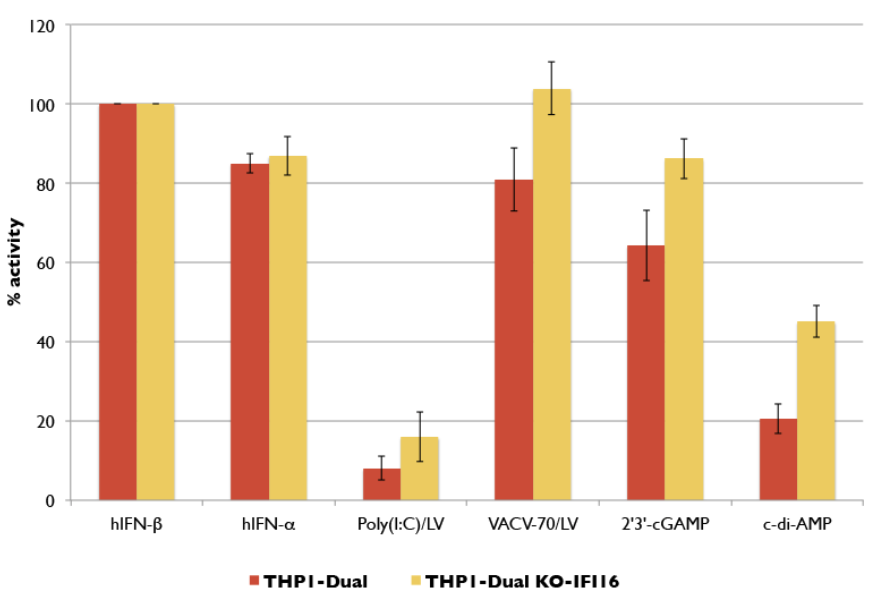THP1-Dual™ KO-IFI16 Cells
| Product | Unit size | Cat. code | Docs. | Qty. | Price | |
|---|---|---|---|---|---|---|
|
THP1-Dual KO-IFI16 Cells Human THP-1 Monocytes - IFI16 knockout NF-κB-SEAP and IRF-Lucia Reporter Cells |
Show product |
3-7 x 10e6 cells |
thpd-koifi16
|
|
||
|
THP1-Dual™ KO-IFI16 vial Additional cell vial |
Show product |
3-7 x 10e6 cells |
thpd-koifi16-av
|
Notification: Reference #thpd-koifi16-av can only be ordered together with reference #thpd-koifi16.
IFI16 knockout dual reporter monocytes
THP1-Dual™ KO-IFI16 cells were generated from THP1-Dual™ cells by stable knockout of the IFI16 (Interferon-γ-inducible protein 16) gene. IFI16 is an innate immune sensor with multiple functions; DNA sensor, regulator of interferon (IFN) expression, activator of the inflammasome, and regulator of genome function [1,2]. These cell lines were derived from human THP‑1 monocytes, a cell line often used to study DNA sensing pathways as they express all the cytosolic DNA sensors identified so far (with the exception of DAI).
THP1-Dual™ and THP1-Dual™ KO-IFI16 cells stably express two inducible secreted reporter genes: IFN-inducible Lucia luciferase and NF‑κB-inducible SEAP (secreted embryonic alkaline phosphatase). They can be used to study the role of IFI16 by monitoring IRF-induced Lucia luciferase activity, using QUANTI‑Luc™, a Lucia™ luciferase detection reagent.
THP1-Dual™ KO-IFI16 cells are resistant to the selectable markers blasticidin and Zeocin®.
References:
1. Jakobsen MR. & Paludan SR., 2014. IFI16: At the interphase between innate DNA sensing and genome regulation. Cytokine Growth Factor Rev. 25(6):649-55.
2. Unterholzner L. et al., 2010. IFI16 is an innate immune sensor for intracellular DNA. Nat Immunol. 11(11):997-1004.
Specifications
Antibiotic resistance: Zeocin®, blasticidin
Growth medium: RPMI 1640, 2 mM L-glutamine, 25 mM HEPES, 10% heat-inactivated fetal bovine serum, 100 μg/ml Normocin™, Pen-Strep (100 U/ml-100 μg/ml)
Quality control
Biallelic IFI16 knockout was verified by functional assays, PCR, and DNA sequencing.
These cells are guaranteed mycoplasma-free.
Contents
- 1 vial of THP1-Dual™ KO-IFI16 cells (3-7 x 106 cells) in freezing medium
- 1 ml of Normocin™ (50 mg/ml). Normocin™ is a formulation of three antibiotics active against mycoplasmas, bacteria and fungi.
- 1 ml of Zeocin® (100 mg/ml)
- 1 ml of Blasticidin (10 mg/ml)
- 1 tube of QUANTI-Luc™ 4 Reagent, a Lucia luciferase detection reagent (sufficient to prepare 25 ml)
- 1 ml of QB reagent and 1 ml of QB buffer (sufficient to prepare 100 ml of QUANTI-Blue™ Solution, a SEAP detection reagent)
![]() Shipped on dry ice (Europe, USA, Canada and some areas in Asia)
Shipped on dry ice (Europe, USA, Canada and some areas in Asia)
Description
THP1-Dual™ and THP1-Dual™ KO-IFI16 cells stably express two inducible secreted reporter genes: Lucia luciferase and SEAP (secreted embryonic alkaline phosphatase). The Lucia luciferase reporter gene is under the control of an ISG54 (interferon-stimulated gene) minimal promoter in conjunction with five IFN-stimulated response elements. The SEAP gene is driven by an IFN-β minimal promoter fused to five copies of the NF‑κB response element. As a result, they allow the simultaneous study of the IFN regulatory factor (IRF) pathway, by assessing the activity of Lucia luciferase and the NF-κB pathway, by monitoring the activity of SEAP. Both reporter proteins are readily measurable in the cell culture supernatant when using QUANTI‑Luc™, a Lucia™ luciferase detection reagent and QUANTI-Blue™, a SEAP detection reagent.
Back to the top







